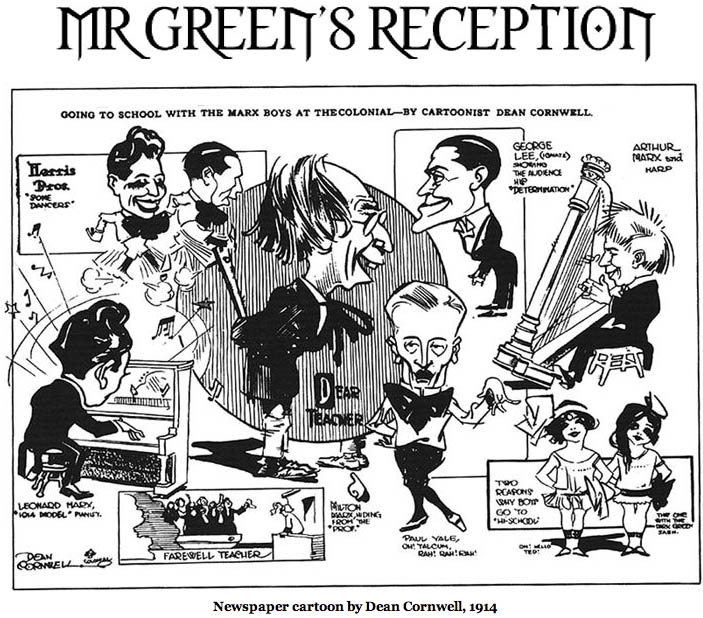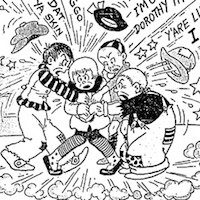The New York Comics & Picture-Story Symposium is a weekly forum for discussing the tradition and future of text/image work. Open to the public, it meets Tuesday nights 7-9 p.m. EST in New York City. Presentations vary weekly and include everything from historical topics and technical demonstrations to creators presenting their work. Check out upcoming meetings here.
The 119th meeting of the New York Comics & Picture-Story Symposium was held on Tuesday, March 31, 2015. In the first of two presentations, Rick DesRochers led a discussion on the Marx Brothers and Americanization. In the second presentation, Ian Gordon gave a talk titled, “The Boy Comic Strip: Towards an International History of Comics.”
***
What do the Marx Brothers have to do with Ben Katchor’s New York Comic and Picture Story Symposium? Certainly, both the Marx Brothers and the newspaper funnies entertained the masses during the first part of the 20th century with broad, often lowbrow humor. But what’s the real connection?
Film and vaudeville scholar Rick DesRochers hits upon the principal element they share: the caricature of Europeans who came to the US after the turn of the 20th century—those huddled masses yearning to be free, who filled tenements and squeezed into urban neighborhoods. Jews, Italians, Poles and Irishmen—who are these people? Were they Americans? Should they be welcomed—and how could we best make fun of them? These are underlying themes beneath both Marx Brothers comedy and the stereotypes that populated the four-color funnies printed in that other most mass-oriented of media, newspapers.
When Groucho points at the mock-Italian Chico and says, “There’s my argument—restrict immigration!” in one of the brothers’ movies, it isn’t just one more Groucho-esque put-down. The line had gotten a laugh when it was first spoken back in one of the brothers’ earliest vaudeville sketches, and they’d been getting use out of it for years. Immigration was an emotional issue in the early 20th century. Groucho, like his brothers, was the son of European Jewish immigrants struggling to make a life in the Unites States— and yet he was pointing out a character who should not have been let into the country in the first place.
The most durable vehicle for the Marx Brothers’s parody was a vaudeville routine loosely called the “school act,” which portrayed a teacher with a foreign accent teaching English incorrectly to the dumbkopfs, delinquents, and incorrigibles who saw no point in learning it. The original school act,  by Gus Edwards (Smith and Dale also did one), featured the well-known “Golden Rule Days” song and nostalgia for corporal punishment. The Marx Brothers first performed their school act, titled “Fun in Hi Skule,” at the Lyda Theatre in Chicago in 1911. It morphed into “On the Balcony” in 1921, and then finally into “Mister Green’s Reception,” with Groucho as Herr Teacher—Groucho dropped the German when the Lusitania was sunk in 1915—teaching hopeless immigrant stereotypes. Harpo played the red-haired Irishman Patsy Brannigan, Chico was the Italian, and Gummo played the Jew named Izzy. No matter how the teacher carries on, slapping two barell staves together—that slapstick descended from commedia dell’arte—the immigrant stereotypes resist this education. Are they resisting assimilation? Or Americanization? Or are they just plain stupid?
by Gus Edwards (Smith and Dale also did one), featured the well-known “Golden Rule Days” song and nostalgia for corporal punishment. The Marx Brothers first performed their school act, titled “Fun in Hi Skule,” at the Lyda Theatre in Chicago in 1911. It morphed into “On the Balcony” in 1921, and then finally into “Mister Green’s Reception,” with Groucho as Herr Teacher—Groucho dropped the German when the Lusitania was sunk in 1915—teaching hopeless immigrant stereotypes. Harpo played the red-haired Irishman Patsy Brannigan, Chico was the Italian, and Gummo played the Jew named Izzy. No matter how the teacher carries on, slapping two barell staves together—that slapstick descended from commedia dell’arte—the immigrant stereotypes resist this education. Are they resisting assimilation? Or Americanization? Or are they just plain stupid?
Their 1932 classic “Horse Feathers,” with its university setting, was the ultimate version of the school act. But it was “Monkey Business” (1931) that heralded the end of the glory days of immigration humor and ethnic caricature, with the brothers playing stowaways who hide in pickle barrels. Afterward, Will Hays came in and tamed Hollywood, and ethnic humor diminished. Star status was conferred upon white Anglo-Saxons. In the new era of Katherine Hepburn, Cary Grant, and Golden Hollywood, studios changed actors’ names to sound non-ethnic, and screwball comedy replaced absurdity and anarchy.
Like many vaudevillians, the Marx Brothers, with their outrageous stage makeup, are cartoony figures. Like the characters in Hogan’s Alley or The Katzenjammer Kids, they’re offensive and rude. And like the Sunday funnies that entertained Depression era audiences, there remains something outrageous, inexcusable, and ultimately, funny about this humor. We still love this broad comedy, even after the Hays Code and anti-defamation leagues have come and gone.
*
Historian Ian Gordon began his presentation, “The Boy Comic Strip: Towards an International History of Comics,” by pointing out that comics go way, way, back.
It sounds like heresy, but comics go way back before The Yellow Kid. And they’ve always been an international phenomenon. Gordon’s thesis is that comics sprouted up not nation by nation, but genre by genre—in particular, the “mischievous boy,” or “kid,” comic. He begins his roster with an early strip by F. M. Howarth from Life, Feb 27, 1890, and continues with Ally Sloper, Max and Moritz, Jim and Jay, Buster Brown, Perry Winkle, Skippy, Ginger Meggs, and Sid Nichol’s Fatty Finn.
International, indeed, they are. The role of Wilhelm Busch’s Max und Mortiz in inspiring Rudolph Dirks’s Katzenjammer Kids is widely acknowledged. Scholar David Kunzle has made us aware of the Swiss cartoonist Rodolphe Töpffer. Fan-historians such as Robert Beerbohm have insured that the European place in the development of comics is widely appreciated. Finally, Australian comic strips appeared in the Bulletin, a weekly magazine established in 1880 that lured even the American artist Livingston Hopkins, who had worked for Judge, to Australia. (The magazine also acquired the necessary technology of photo engraving to reproduce better quality illustrations.) Another Australian, Pat Sullivan, published a comic in a 1907 edition of The Gadfly and then went to the US and, depending on who you believe, created Felix the Cat.
A three-panel strip by Hopkins, from a July 1883, issue of the Bulletin, exemplifies the kind of humor that worked across cultures. An Episode of the North Shore Ferry depicts a ferry service between the two sides of a harbor and characters dressed in the styles of the well‑to‑do. Each man is in such a hurry that he’s prepared to jump from wharf to ferry and vice versa. Instead, they slam into each other. The joke would work in any harbor city, and Gordon expects that one day someone will turn up using the same gag but referring to the Brooklyn ferry.
The cavalcade of kid strips also demonstrates some similarities. You can find boys racing soap-box derbies (or “billy carts”) on both sides on the Atlantic. Differences, though, become apparent with a little bit of scholarship. The French Excelsior Dimanche carried French translations of two Chicago Tribune comic strips in the 1920s, The Gumps (La famille Mirliton, literally, “the Kazoo Family”) and Perry Winkle, kid brother of Winnie Winkle.
The widely popular Winnie Winkle starred a heroic, fashionable, pre-flapper working girl, who always aimed to break into a more glamorous life and dealt with changes in social mores. While Winnie’s adventures dominated the dailies, in the 1920s the Sunday page of this strip was almost exclusively turned over to the antics of little brother Perry and his friends, the Rinkie Dinks. The French version of Perry Winkle’s Sunday adventures, published from 1923 onwards, was titled Bicot, President de Club (“bicot” roughly means “street urchin”).
There was a different tone when the comic was translated into French. Racial humor was excised, and entire characters were removed from panels. Bicot pages, when contrasted with their with American Sunday counterparts featuring Perry Winkle, show what works across cultures and what doesn’t, and can even reveal differences in visual puns when the illustrations are altered. This is uncharted territory for comic strip scholars, and is the primary direction Ian Gordon is taking with his investigation of international comics and their featured kids.
***
Image credits:
1. Ad for the Marx Brothers “Mr. Green’s Reception.” (Public Domain)
2. “Perry Winkle and his Rinky Dinks,” in English. (Public Domain)
3. “Perry Winkle” translated into French. (Public Domain)
***
Rick DesRochers, Ph.d., is an Associate Professor of Theatre at Long Island University Post. He has served as the Literary Director of New Play and Musical Development for the Joseph Papp Public Theater/New York Shakespeare Festival and The Goodman Theatre of Chicago, as well as the Artistic Director of the New Theatre in Boston. He holds an MFA in stage direction and dramaturgy from the University of Massachusetts at Amherst, and a PhD in theatre from the City University of New York, Graduate Center.
Ian Gordon is an Associate Professor in History at the National University of Singapore. For the academic year 2014-2015 he is a visiting scholar at NYU’s Department of Social and Cultural Analysis. He is the author of Comic Strips and Consumer Culture, and editor of two collections Comics & Ideology, and Film and Comic Books.
***
About the author: Mark Lerer holds a bachelor’s degree from Princeton University and an MFA from the New York Academy of Art. He has been the Art Director of Street News, and published a study of Will Eisner for the Museum of Comic and Cartoon Art. His cartoon drawings have been run in the New York Post, appeared at New Century Artists and Nexus galleries, and are regularly featured on Facebook.






